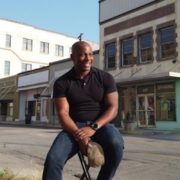After years of working in states across the US, engineer and entrepreneur Brian Rice decided he wanted to invest in his hometown of Birmingham, Alabama.
By Ivana Davidovic, BBC News
He had enough cash to buy eight buildings, all around 100 years old, in his majority black neighbourhood of Ensley, but he needed a banking loan to redevelop them. He thought it would be just a formality.
What he discovered was a system stacked against people like him.
“I thought it was the worst appraisal in the United States,” he says, recalling the moment he opened the valuation the bank had given him for his properties and read its justification.
“They compared my eight historic properties to farmland 14 or so miles away, and they compared my buildings to an abandoned car wash. Nothing about my properties resembles those.”
— Credits & Context
Featured Image, BRIAN RICE
Full article @ BBC News
RELATED: Birmingham, Alabama
Birmingham (/ˈbɜːrmɪŋhæm/ BUR-ming-ham) is a city in the north central region of the U.S. state of Alabama. With an estimated 2019 population of 209,403, it is the most populous city in Alabama. Birmingham is the seat of Jefferson County, Alabama’s most populous and fifth largest county. As of 2018, the Birmingham-Hoover Metropolitan Statistical Area had a population of 1,151,801, making it the most populous in Alabama and 49th-most populous in the United States. Birmingham serves as an important regional hub and is associated with the Deep South, Piedmont, and Appalachian regions of the nation.
Birmingham was founded in 1871, during the post–Civil War Reconstruction era, through the merger of three farm towns, most notably Elyton. The new city was named for Birmingham, England, the United Kingdom’s second largest city and then a major industrial city. The Alabama city annexed its smaller neighbors as it developed into a major industrial center based on mining, the iron and steel industry, and rail transport. Most of the original settlers were of English ancestry. The city was developed as a place where low paid, non-unionized immigrants (mainly Irish and Italian), along with African-Americans from rural Alabama, who worked in the city’s steel mills and blast furnaces and gave it a competitive advantage over unionized industrial cities of the Midwest and Northeast.
Based on the 2000 census, there were 242,820 people, 98,782 households, and 59,269 families residing in the city. The population density was 1,619.7 people per square mile (625.4/km2). There were 111,927 housing units at an average density of 746.6 per square mile (288.3/km2). The racial makeup of the city was 62.46% Black, 35.07% White, 0.17% Native American, 0.80% Asian, 0.04% Pacific Islander, 0.62% from other races, and 0.83% from two or more races. 1.55% of the population were Hispanic or Latino of any race.
There were 98,782 households, of which 27.7% had children under the age of 18 living with them, 31.1% were married couples living together, 24.6% had a female householder with no husband present, and 40.0% were non-families. 34.4% of all households were made up of individuals, and 10.4% had someone living alone who was 65 years of age or older.
The city’s population is spread out, with 25.0% under the age of 18, 11.1% from 18 to 24, 30.0% from 25 to 44, 20.4% from 45 to 64, and 13.5% who were 65 years of age or older. The median age was 34 years. For every 100 females, there were 85.7 males.
The city’s median household income was $31,898, and the median family income was $38,776. Males had a median income of $36,031 versus $30,367 for females. The city’s per capita income was $19,962. About 22.5% of families and 27.3% of the population were below the poverty line, including 41.9% of those under the age of 18 and 18.3% of those age 65 or over.
Source – Birmingham, Alabama (Updated: 17 September 2020) Wikipedia. Available at https://en.wikipedia.org/wiki/Birmingham%2C_Alabama (Accessed: 29 September 2020)

